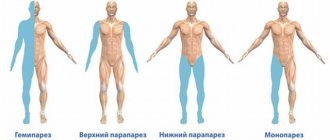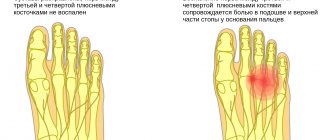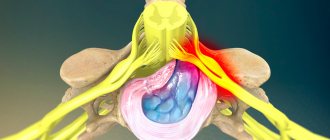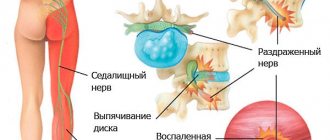Lambert-Eaton myasthenic syndrome is a pathology that manifests itself as muscle weakness and fatigue at the slightest load, which is especially noticeable in the legs and lower torso. Patients also complain that severe pain, called myalgia, appears in these places.
The main manifestation is difficulty when trying to rise to your feet from a sitting or lying position. Sometimes a disorder of the autonomic nervous system also develops.
Most often, the disease develops in men after 40 years of age. The main concomitant pathology is considered to be a malignant neoplasm, and in 80% of all cases it will be small cell lung cancer. Its manifestations can be so pronounced at the time of diagnosis of Lambert-Eaton syndrome that both diagnoses are made in a fairly short period of time.
Only in the rarest cases does the syndrome develop without accompanying cancer.
As for women, this pathology is idiopathic (unexplained) in nature and occurs against the background of some autoimmune diseases, as well as with pathology of the thyroid gland, diabetes mellitus and myasthenia gravis.
What are the main manifestations of MIA-Lambert-Eaton syndrome (MLES)?
The main symptoms of MSLI are weakness and pathological fatigue of the proximal muscles, hip muscles and pelvic girdle, weakening or loss of tendon reflexes. Muscle strength and tendon reflexes can increase for a short time after physical activity (post-exertional relief). Although ptosis may occur in MSLI, the extrinsic oculi and tabulus muscles are usually minimally affected. Moderate autonomic dysfunction may be observed, which is primarily manifested by dry mouth.
Etiology and mechanism of development
The etiology of myasthenia gravis and related syndromes has not been sufficiently studied by modern science. But information about the mechanism of its occurrence somewhat lifts the veil of secrecy.
In a split second, traveling from the brain center to the muscle fiber, the nerve signal makes a complex journey. The impulse comes from the brain to muscle tissue through a special formation - a synapse. This structure is located between the nerve cell and the muscle fiber and ends in the presynaptic membrane. A mediator substance, acetylcholine, accumulates on this membrane. The mechanism of impulse transmission also involves the enzyme acetylcholinesterase and the receptor located on the second membrane - the postsynaptic membrane. Research by scientists has shown that in myasthenia gravis, the cause of the disease is a pathology affecting the receptor. As for myasthenic syndromes, they develop due to disruptions in the functioning of pre- or postsynaptic membranes.
If the functioning of the first of the membranes is disrupted, then the cause of the disease may be a decrease in tiny glands - vesicles containing acetylcholine. In many cases, myasthenic syndrome is caused by disturbances in the production of this enzyme itself, and not by its deficiency. The list of possible pathologies of the second membrane is wider. In addition to the incorrect production of the acetylcholinesterase mediator, its deficiency and defects in the structure of the synaptic cleft and the receptors themselves are added. All this impairs the transmission and perception of nerve signals in the brain, creating an effect vaguely reminiscent of the children’s game of “broken telephone.”
The role of the genetic factor in the development of the disease has not been proven, but there are still some cases where close relatives suffer from myasthenia gravis.
What tumor is associated with MSLI?
Approximately 50-66% of patients with MSLI are diagnosed with cancer, usually small cell lung cancer. A malignant neoplasm can be diagnosed when neurological symptoms appear or later, but usually within the first 2 years. Although immunological evidence suggests that tumor may play an important role in the pathogenesis of MSLI, a minority of patients with MSLI never develop a malignant process.
What experimental data indicate the autoimmune pathogenesis of MSLI?
Passive transfer of IgG from patients with MSLI to animals leads to electrophysiological abnormalities characteristic of MSLI. In the IgG fraction in MSLI, antibodies against potentiometer-dependent calcium channels are detected.
Diagnostics
The diagnosis is made by a neurologist. For this purpose, a detailed anamnesis is collected - all complaints are listened to carefully. A neurological examination and electroneuromyography are performed. A chest x-ray is also required to determine the presence of small cell lung cancer.
Since this is one of the neoplasia syndromes, in the absence of pathology in the lungs, tests for tumor markers and MRI of the abdominal cavity, brain, spine, and ultrasound of the thyroid gland should be performed.
If the autoimmune nature of the disease is suspected, appropriate studies are prescribed. We must also remember that in this case the disease can occur not only in men, but also in women.
Describe the pathophysiology of the autoimmune process in MSLI.
The main antigen against which an autoimmune attack is launched in MSLI is found in the area of the terminal end and small cell lung cancer cells. Antibodies in MSLI cross-react with N- and L-type voltage-gated calcium channels and synaptotagmin in presynaptic terminals, reducing the number of voltage-gated calcium channels, which prevents the activation of the cascade leading to the release of ACh from presynaptic vesicles. Decreased ACh release reduces depolarization in the muscle endoplasty, resulting in the muscle fiber activation threshold not being reached.
What is pathology
Lambert-Eaton myasthenic syndrome is an autoimmune disease characterized by impaired neuromuscular conduction.
Reference. The syndrome was studied by American neurophysiologists Lambert and Eaton.
The triggering mechanism for the development of the disease is the occurrence of a disorder in the presynaptic membrane of the synapse (the functional unit through which the impulse is carried out from one neuron to a neuron or to a muscle cell). The consequence of this pathological process is difficulty in conducting the impulse.
The pathology affects people aged 20 to 70 years. At first, the disease was detected mainly in men. But, based on the observations of specialists, we can conclude that recently the pathology has begun to occur more often in female representatives.
This syndrome belongs to the category of rather complex pathological phenomena, accompanied by a large number of specific symptoms.
How is MSLI treated?
The release of acetylcholine from presynaptic terminals is enhanced by guanidine hydrochloride, 4-aminopyridine and 3,4-diaminopyridine. Amino-pyridines, especially 4-aminopyridine, lower the epileptic threshold. In some patients, the condition may improve with anticholinesterase drugs. In the case of paraneoplastic syndrome, the best option is to treat the underlying disease, which can lead to complete remission. Although improvement has been described with intravenous immunoglobulin and other types of immunotherapy (plasmapheresis, oral corticosteroids), the results of such treatment are often disappointing.
Treatment
Treatment for Lambert-Eaton myasthenic syndrome depends on the cause of its occurrence.
Thus, if the origin of the syndrome is oncological, therapy is based on the elimination of the tumor process . If tumor removal is successful, a decrease in symptoms is observed.
If the cause of the syndrome is an autoimmune disorder, then symptomatic treatment with medications is used.
medications are mainly used
- anticholinesterase drugs - to inhibit the production of enzymes, reduce muscle fatigue,
- potassium preparations - to improve the contractility of muscle tissue,
- antioxidants - to improve metabolism and saturate the body with necessary substances.
In severe cases of the disease, hormone therapy, cytostatics, blood purification using plasmapheresis, and the administration of immunoglobulins may be prescribed.
Important! Drug therapy is carried out for years, and from time to time requires dosage adjustments or changes in medication.
Folk remedies
This pathology is autoimmune, which means it requires the use of specific therapeutic techniques.
In this regard, treatment of myasthenic syndrome with folk remedies is impractical and ineffective, and even moreover, dangerous.
Without receiving the necessary medical care or replacing it with traditional treatment, the patient’s condition may sharply worsen and develop a crisis with generalized muscle weakness. This condition may threaten the subsequent development of acute cerebral hypoxia and disorders of consciousness.
The effectiveness of using folk remedies in parallel with official therapy is unlikely to be noticeable.
If you want to try alternative medicine, it is better to do this only after consultation with a specialist and subject to his approval.
Reasons for the development of the disease
Today there is still no comprehensive answer to the question: what are the causes of the development of myasthenic syndrome?
Many scientists agree that the factor of heredity plays a big role here. By collecting medical history data, most often the doctor finds out that the patient has or had close relatives suffering from this pathology. Often the course of the syndrome is accompanied by:
- hyperplasia or tumor of the thymus gland;
- dermatomyositis;
- amyotrophic lateral sclerosis;
- cancer of the lung, ovary or breast.
In such a situation, myasthenia gravis is not an independent disease, but a syndrome. Various unfavorable factors (poor immunity, frequent stress, infectious diseases) provoke a healthy body to produce antibodies to its own cells, under the influence of which the postsynaptic membrane is destroyed.
As a result of this, the transmission of impulses weakens, and gradually they fade away completely.
Symptoms
The main symptom that distinguishes Lambert's syndrome from ordinary myasthenia is localization. In the first case, the lower extremities are affected, whereas with the usual type of illness, the entire body is in the affected area.
In addition to weakness and excessive fatigue, there are other signs including:
- decreased sweating and salivation;
- orthostatic hypertension;
- lack of pupillary reaction to light;
- erectile dysfunction in men;
- decreased visual acuity;
- double vision;
- change in voice timbre and diction (the appearance of nasality and loss of speech clarity);
- painful sensations when swallowing;
- breathing problems;
- tachycardia;
- disorders in the gastrointestinal tract (GIT).
Gradually, the patient begins to experience problems with walking, unsteadiness in gait appears, and difficulties with climbing stairs appear. Pain in the neck and back may occur.
In addition, the patient begins to experience problems getting up from a chair or bed. As a rule, it costs him serious muscle effort.
With this disease, a cholinergic crisis may develop, which has symptoms opposite to Eaton-Lambert syndrome, in particular:
- reduction in heart rate;
- constriction of the pupils;
- increased uncontrolled drooling;
- increased secretion of bronchial mucus.
If such signs are present, the patient must be immediately taken to the hospital, as this is dangerous not only for his health, but also for his life.
Congenital myasthenic syndromes
A symptom of congenital myasthenia is weak fetal movement. It is most often diagnosed in boys; they get sick twice as often as girls, but the congenital form of the disease itself is rare.
In congenital syndromes, the extraocular muscles are primarily affected (ophthalmoplegia). The newborn exhibits immobility or limited mobility of the eyes. The child does not move his gaze, does not look for his mother, turning his head towards her voice. This is detected in the first weeks of the baby’s life.
In addition to the almost complete absence of eye movements, the child has drooping eyelids. Most often, therapeutic measures do not help cure ophthalmoplegia.
There is a known type of myasthenic syndrome, which combines muscle hypotonia and underdevelopment of the synaptic apparatus. It is less common than others and cannot be treated. Patients have skeletal development anomalies, asymmetry of face and body shapes, and in girls – underdevelopment of the mammary glands.
In addition to these types, there are a number of myasthenic syndromes associated with the work of ion channels, with underdevelopment of the synaptic apparatus, with the use of antibiotics, etc. But they are not that common.
Preventive measures
The main prevention of myasthenia gravis is a healthy lifestyle.
Statistics show that the development of the disease is influenced by a person’s weight, and this can be either obesity or excessive thinness. Every person's diet should be rich in vitamins and microelements; a lack of these substances can cause disease.
If the patient has a genetic predisposition, he must properly plan physical activity, since muscle overstrain can have an extremely negative impact on them. However, physical exercise cannot be completely excluded. For good metabolism, tissues need a warm-up.
Myasthenia gravis, since it is an autoimmune disease, can easily develop in a person with poor immunity. Therefore, strengthening the immune system is an important link in the prevention complex. Good immunity, if it does not prevent the disease, will soften its symptoms and reduce the risk of relapse.
Transigorous neonatal myasthenia gravis
Neonatal myasthenia is diagnosed in children whose mothers suffer from myasthenia. Signs of the disease are pronounced muscle hypotonia, weak voice, frequent shallow breathing, difficulty sucking.
Such a child is inactive, his movements of arms and legs are sluggish. When treated with injections of anticholinesterase drugs, these phenomena disappear after 2-2.5 months. Without treatment, the baby may die from pathologies of the swallowing muscles and other bulbar disorders.
Infantile myasthenia gravis develops before 1-2 years of life, most often affecting the oculomotor muscles. However, pathological processes can affect the muscles of facial expression and mastication.










